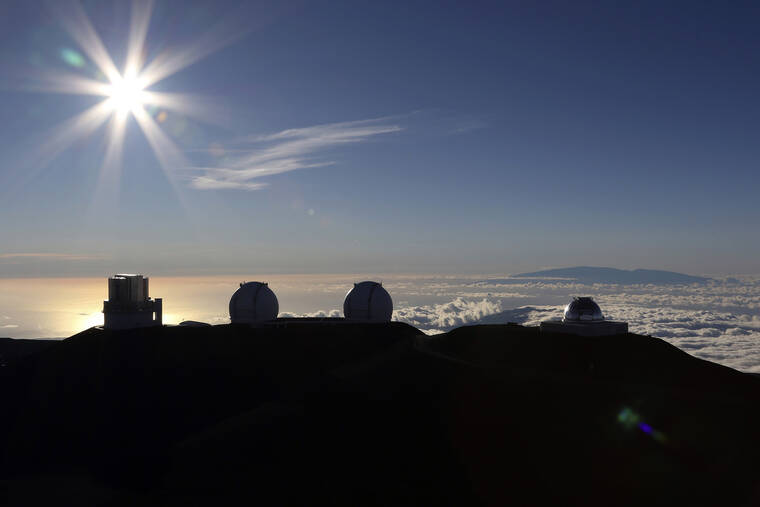‘Governing Entity’ proposed by Mauna Kea Working Group

The sun sets behind telescopes in 2019 at the summit of Maunakea. (AP Photo/Caleb Jones, File)
University of Hawaii representatives have pushed back against a report recommending that the state create a new organization to manage Maunakea.
University of Hawaii representatives have pushed back against a report recommending that the state create a new organization to manage Maunakea.
The Mauna Kea Working Group was formed earlier this year by a resolution in the state House of Representatives in order to investigate possible alternative management structures for Maunakea, whose summit lands are currently being managed by the university.
The group released a draft report Friday, which recommended that management of the mountain transition to a new body — referred to only as the Governing Entity — over the course of three years. Hilo Rep. Mark Nakashima, chair of the working group, said during a news conference Friday that he hopes to introduce legislation that will formally create the body during the 2022 legislative session.
The working group was formed partly in response to an assessment from the Department of Land and Natural Resources last year that determined that UH’s management of the mountain had not appropriately engaged with local and Native Hawaiian communities.
The group’s report — titled He La Hou Keia Ma Mauna A Wakea: A New Day on Mauna A Wakea — includes several pages discussing the historical and cultural significance of the mauna and alternates freely between referring to the mountain as Maunakea and Mauna a Wakea, a traditional name for the mountain.
The report proposes that the Entity would be attached to the Office of the Chairperson of the Board of Land and Natural Resources and would be headed by a nine-member board, largely composed of Native Hawaiian residents on the Big Island: at least seven of the members would be required to be Native Hawaiian Big Islanders, and another three would be selected with a preference for Native Hawaiian Big Islanders.
Specifically, the board’s membership would be made up of two Hawaii Island residents with expertise in resource management and land and infrastructure management; someone with education experience; someone with business and finance experience; and three Native Hawaiian cultural practitioners nominated by the Office of Hawaiian Affairs.
The remaining two members would be the chair of the BLNR and the CEO of OHA.
“We talked about who should be members of the group and who really deserves a seat at the table, who are the stakeholders, who are the rights holders,” Nakashima said, adding that the working group had discussed including a seat for a representative of the astronomy community, but ultimately decided against it.
The Governing Entity would, under the terms proposed by the report, be the sole authority for the management of all state-owned lands above the 6,500-foot level, a larger area than the lands currently managed by UH — the proposed jurisdiction of the Governing Entity would extend from the summit all the way down to Pu‘u Huluhulu at the base of Maunakea Access Road.
Nakashima said the immediate fate of the current Maunakea Observatories if the Governing Entity takes over management is not yet decided — the group has not determined whether the observatories will be able to renew land use agreements beyond the end of UH’s current Master Lease, which ends in 2033, and continue to operate until the end of their effective lifespan.
Nakashima also said that the question of whether the Thirty Meter Telescope could still be built if Maunakea were under the governance of the Entity fell outside of the scope of the working group.
However, the observatories’ ultimate fate is clear from the report, which dictates that the Governing Entity “shall develop a framework to limit astronomy development on the mauna…provided that in establishing a framework to control astronomy development on the mauna, the Governing Entity shall establish a plan to return the mauna above 9,200 feet elevation to its natural state.”
Although the working group included among its members UH-Hilo Chancellor Bonnie Irwin, UH officials disagreed with the report’s central premises. Greg Chun, executive director of UH’s Center for Maunakea Stewardship, said during a Friday news conference that the Governing Entity could not unilaterally decide to end astronomy on the mountain.
“Astronomy on Maunakea is a state policy,” Chun said. “And that is not a decision that a single governing agency, UH or otherwise, can make on their own. These are public lands and it’s the responsibility of any governing agency to consider the multiple values ascribes to…Maunakea. And if we, as a state, are going to take the position that astronomy is no longer one of those values…that’s a broader discussion.”
Chun added that the ongoing revisions to UH’s Master Plan and Comprehensive Management Plan predate the formation of the working group and address many of the same concerns regarding community outreach that influenced the group’s creation.
Chun said the university will continue to seek an extension of its land leases on the summit, but reiterated concerns that the state will have to make a decision soon: should the extension not be approved, the existing Maunakea observatories will have to be decommissioned by 2033.
“That’s independent of either governing body being in control, that’s hardwired into the land use agreement,” said Doug Simons, director of UH’s Institute for Astronomy, adding that, given how long the decommissioning process takes, every summit observatory has only about five more years of operational life left if their land use agreements are not extended.
The working group’s draft report is available for review at tinyurl.com/y2xbd2pb.
Public comments on the report are being accepted until Jan. 4 and can be sent to maunakeaWG@capitol.hawaii.gov.
Nakashima said the working group will reconvene in January to discuss public feedback.
Email Michael Brestovansky at mbrestovansky@hawaiitribune-herald.com.


